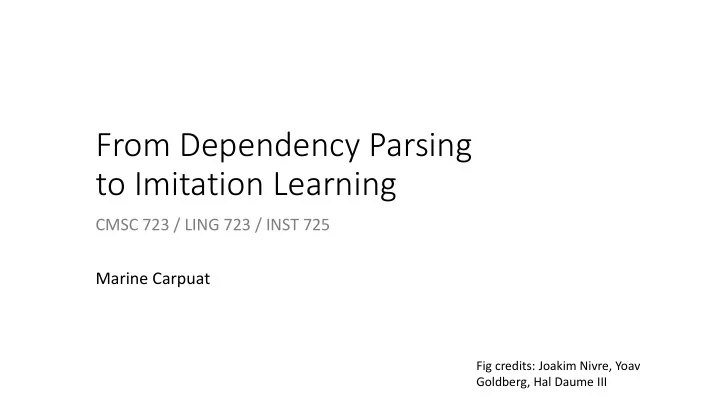

From Dependency Parsing to Imitation Learning CMSC 723 / LING 723 / INST 725 Marine Carpuat Fig credits: Joakim Nivre, Yoav Goldberg, Hal Daume III
T oday’s topics: Addressing compounding error • Improving on gold parse oracle • Research highlight: [Goldberg & Nivre, 2012] • Imitation learning for structured prediction • CIML ch 18
Improving the oracle in transition-based dependency parsing • Issues with oracle we’ve used so far • Based on configuration sequence that produces gold tree • What if there are multiple sequences for a single gold tree? • How can we recover if the parser deviates from gold sequence? • Goldberg & Nivre [2012] propose an improved oracle
Exercise: which of these transition sequences produces the gold tree on the left?
Dependency Arc from position j to position i, Buffer Stack Arcs with dependency label l
Which of these transition sequences does the oracle algorithm produce?
Improving the oracle in transition-based dependency parsing • Issues with oracle we’ve used so far • Based on configuration sequence that produces gold tree • What if there are multiple sequences for a single gold tree? • How can we recover if the parser deviates from gold sequence? • Goldberg & Nivre [2012] propose an improved oracle
SHIFT At test time, suppose the 4 th transition predicted is SHIFT instead of RA IOBJ What happens if we apply the oracle next?
Measuring distance from gold tree • Labeled attachment loss: number of arcs in gold tree that are not found in the predicted tree Loss = 1 Loss = 3
Improving the oracle in transition-based dependency parsing • Issues with oracle we’ve used so far • Based on configuration sequence that produces gold tree • What if there are multiple sequences for a single gold tree? • How can we recover if the parser deviates from gold sequence? • Goldberg & Nivre [2012] propose an improved oracle
Proposed solution: 2 key changes to training algorithm Any transition that can possibly lead to a correct tree is considered correct Explore non-optimal transitions
Proposed solution: 2 key changes to training algorithm
Defining the cost of a transition • Loss difference between minimum loss trees achievable before and after transition • Loss for trees nicely decomposes into losses for arcs • We can compute transition cost by counting gold arcs that are no longer reachable after transition
T oday’s topics Addressing compounding error • Improving on gold parse oracle • Research highlight: [Goldberg & Nivre, 2012] • Imitation learning for structured prediction • CIML ch 18
Imitation Learning aka learning by demonstration • Sequential decision making problem • At each point in time 𝑢 • Receive input information 𝑦 𝑢 • Take action 𝑏 𝑢 • Suffer loss 𝑚 𝑢 • Move to next time step until time T • Goal • learn a policy function 𝑔(𝑦 𝑢 ) = 𝑧 𝑢 • That minimizes expected total loss over all trajectories enabled by f
Supervised Imitation Learning
Supervised Imitation Learning Problem with supervised approach: Compounding error
How can we train system to make better predictions off the expert path? • We want a policy f that leads to good performance in configurations that f encounters • A chicken and egg problem • Can be addressed by iterative approach
DAGGER: simple & effective imitation learning via Data AGGregation Requires interaction with expert!
When is DAGGER used in practice? • Interaction with expert is not always possible • Classic use case • Expert = slow algorithm • Use DAGGER to learn a faster algorithm that imitates expert • Example: game playing where expert = brute-force search in simulation mode • But also structured prediction
Sequence labeling via imitation learning • What is the “expert” here? • Given a loss function (e.g., Hamming loss) • Expert takes action that minimizes long-term loss Loss of best reachable Output prefix output starting with at time t prefix 𝑧 ∘ 𝑏 • When expert can be computed exactly, it is called an oracle • Key advantages • Can define features • No restriction to Markov features
T oday’s topics • Improving on gold parse oracle • Research highlight: [Goldberg & Nivre, 2012] • Imitation learning for structured prediction • CIML ch 18
Recommend
More recommend